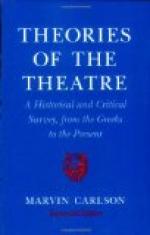This summary statement of the usual process may seem, perhaps, to cast excessive emphasis on the constructive phase of the playwright’s problem; and allowance must of course be made for the divergent mental habits of individual authors. But almost any playwright will tell you that he feels as if his task were practically finished when he arrives at the point when he finds himself prepared to begin the writing of his dialogue. This accounts for the otherwise unaccountable rapidity with which many of the great plays of the world have been written. Dumas fils retired to the country and wrote La Dame aux Camelias—a four-act play—in eight successive days. But he had previously told the same story in a novel; he knew everything that was to happen in his play; and the mere writing could be done in a single headlong dash. Voltaire’s best tragedy, Zaire, was written in three weeks. Victor Hugo composed Marion Delorme between June 1 and June 24, 1829; and when the piece was interdicted by the censor, he immediately turned to another subject and wrote Hernani in the next three weeks. The fourth act of Marion Delorme was written in a single day. Here apparently was a very fever of composition. But again we must remember that both of these plays had been devised before the author began to write them; and when he took his pen in hand he had already been working on them in scenario for probably a year. To write ten acts in Alexandrines, with feminine rhymes alternating with masculine, was still, to be sure, an appalling task; but Hugo was a facile and prolific poet, and could write very quickly after he had determined exactly what it was he had to write.
It was with all of the foregoing points in mind that, in the opening sentence of this chapter, I defined a play as a story “devised,” rather than a story “written.” We may now consider the significance of the next phrase of that definition, which states that a play is devised to be “presented,” rather than to be “read.”
The only way in which it is possible to study most of the great plays of bygone ages is to read the record of their dialogue; and this necessity has led to the academic fallacy of considering great plays primarily as compositions to be read. In their own age, however, these very plays which we now read in the closet were intended primarily to be presented on the stage. Really to read a play requires a very special and difficult exercise of visual imagination. It is necessary not only to appreciate the dialogue, but also to project before the mind’s eye a vivid imagined rendition of the visual aspect of the action. This is the reason why most managers and stage-directors are unable to judge conclusively the merits and defects of a new play from reading it in manuscript. One of our most subtle artists in stage-direction, Mr. Henry Miller, once confessed to the present writer that he could never decide whether a prospective play




